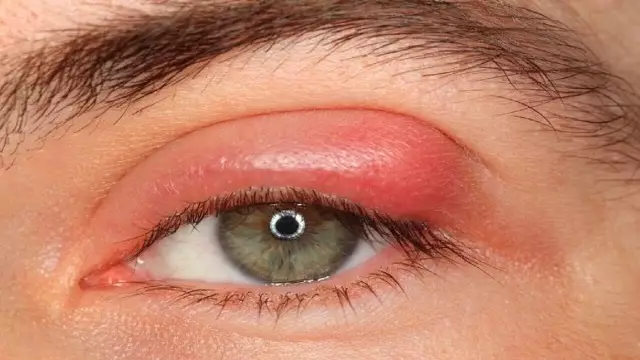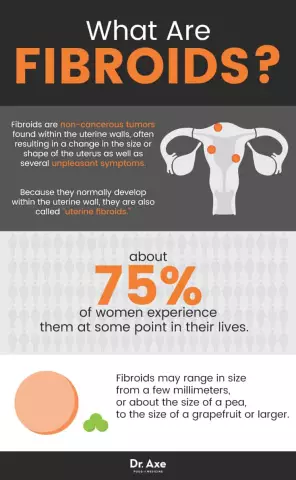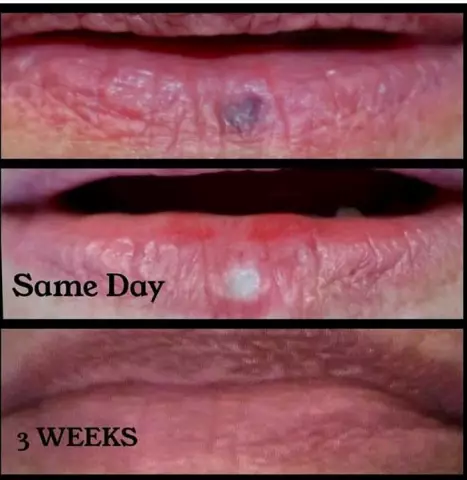- Author Rachel Wainwright [email protected].
- Public 2023-12-15 07:39.
- Last modified 2025-11-02 20:14.
Chaliazion

The term "chalazion" translated from Greek means "hailstone, small knot". This small seal has a rounded shape and fairly clear boundaries. Usually, the chalazion of the century does not dissolve for a long time. It often puts pressure on the eyeball, provoking other eye diseases. Chalazion of the century can develop in both adults and children.
Disease symptoms
The development of chalazion is accompanied by the appearance of a slight swelling of the eyelid, moderate pain and irritation. Usually, all symptoms of the disease disappear after one to two days, but a painful, round swelling may remain on the eyelid. Increased swelling often results in slight blurring of vision. Sometimes a red or gray spot may form on the surface of the eyelid. With significant growth, the chalazion becomes painful and quite hard to the touch.
Chalazion - the causes of the development of the disease
The cause of eyelid chalazion is very common - blockage of the meibolian (sebaceous) gland of the eye. As a result of a blockage, a secretory fluid accumulates in the sebaceous duct, which leads to the development of inflammation and the formation of a seal on the eyelid.
Failure to comply with the rules of personal hygiene is an equally common cause of chalazion. If you often wipe your eyes with unwashed hands, forget to wash your face in the evening, or use contact lenses inaccurately, then dirt and infection can be brought into the eye.
Any condition of the body associated with increased sweating (hormonal changes, diabetes mellitus) is a potential cause of eyelid chalazion.
Chalazion of the eyelid can develop from barley in the absence of treatment or periodic relapses.
Chalazion treatment
In 25% of cases, the disease goes away without treatment. In the treatment of chalazion, hot compresses can be used, followed by an eye massage. They will remove the blockage and release the contents of the inflammatory focus. For compresses, it is best to use wipes soaked in warm water. The compress should be placed on the eyelid for fifteen minutes. The procedure is recommended four to six times a day. After that, you can massage the eyelid in a circular motion for one to two minutes. Conservative treatment (disinfecting drops and applications with yellow mercury ointment) of chalazion is used only at the initial stage of the development of the disease. Corticosteroid therapy is used for advanced forms of the disease. With this method of treatment, steroids are injected directly into the chalazion cavity. Steroids accelerate the absorption of secretions contained in the thickness of the eyelid.

If the corticosteroid treatment did not give the desired results, then in this case they resort to the surgical method of treating chalazion. Under local anesthesia, forceps are applied to the eyelid, then an incision is made in the eyelid conjunctiva, the cavity of the chalazion is carefully peeled off, and its walls are preserved. Then the cavity is filled with a special disinfectant ointment, antibiotics are injected under the conjunctiva. After the operation, an aseptic bandage is applied to the eye for several days.
Chalazion treatment with folk remedies
Chalazion treatment with folk remedies will be appropriate if the seal has appeared recently and has not yet had time to grow. The most common method is applying dry heat to the eye (eggs or heating pads).
Bread crumb poultices work well for pain relief. For this, about one hundred grams of crumb must be placed in a glass of milk. Then add a teaspoon of plantain leaves. Apply the finished poultice to the sore spot.
Alternating cold compresses with hot linseed compresses will be no less effective.
Dill can help remove chalazion. To do this, you need one tablespoon of dill and one and a half glasses of water. Chopped dill is poured with boiled water and allowed to brew for a while. Lotions are made when the broth has cooled.
Aloe and calendula can help with this disease. Ten grams of calendula flowers are steamed with hot water and allowed to brew for about half an hour. Then it is filtered and used for lotions.
You can lubricate the seal with Kalanchoe or aloe juice. Boric acid is often used to treat the disease. First, the eye is washed with boric acid, and then fresh cottage cheese, wrapped in a napkin, is applied to the sore spot.
Marshmallow is considered a very effective folk remedy for the treatment of chalazion. Six grams of marshmallow root is poured with cold water and infused for eight hours. The sore eye is washed with the resulting solution.
For chalazion, you need to take two teaspoons of cornflower flowers and one glass of water. Pour boiling water over the flowers and let it brew for about an hour. Then you should strain the infusion and apply to the affected area.
YouTube video related to the article:
The information is generalized and provided for informational purposes only. At the first sign of illness, see your doctor. Self-medication is hazardous to health!






